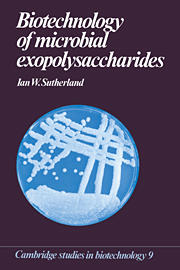Book contents
- Frontmatter
- Contents
- Preface
- 1 Introduction and definition
- 2 Polysaccharide analysis and structural determination
- 3 Exopolysaccharide structure
- 4 Enzymes degrading exopolysaccharides
- 5 Biosynthesis
- 6 Physiology and industrial production
- 7 Genetics, control and regulation of exopolysaccharide synthesis
- 8 Physical properties of exopolysaccharides
- 9 Food usage of exopolysaccharides
- 10 Industrial uses of microbial polysaccharides
- 11 Medical applications of exopolysaccharides
- 12 The future for microbial exopolysaccharides
- References
- Index
7 - Genetics, control and regulation of exopolysaccharide synthesis
Published online by Cambridge University Press: 09 September 2009
- Frontmatter
- Contents
- Preface
- 1 Introduction and definition
- 2 Polysaccharide analysis and structural determination
- 3 Exopolysaccharide structure
- 4 Enzymes degrading exopolysaccharides
- 5 Biosynthesis
- 6 Physiology and industrial production
- 7 Genetics, control and regulation of exopolysaccharide synthesis
- 8 Physical properties of exopolysaccharides
- 9 Food usage of exopolysaccharides
- 10 Industrial uses of microbial polysaccharides
- 11 Medical applications of exopolysaccharides
- 12 The future for microbial exopolysaccharides
- References
- Index
Summary
Introduction
Although some of the earliest studies on bacterial transformation utilised as a model system polysaccharide production in Streptococcus pneumoniae and its relation to virulence, further progress in studying the genetics of polysaccharide synthesis has taken some considerable time. Much effort was applied to studies on the genetics of colanic acid synthesis in E. coli and Salmonella typhimurium, but this has proved to be a very complex system with numerous regulatory mechanisms. The complexity may perhaps be, at least in part, related to the relatively large hexasaccharide repeat unit of this exopolysaccharide and the ability of most bacteria synthesising it to produce more than one extracellular polysaccharide. Recently, however, detailed knowledge of the genetics of exopolysaccharide synthesis has derived from various systems. The interest in xanthan as an industrial product from X. campestris, and in the bacteria per se as plant pathogens, has prompted their study. Rhizobium species, as well as producing at least two different polysaccharides of potential industrial interest, have received attention because of their symbiotic relationship with leguminous plants and the associated bacterial fixation of dinitrogen. Alginate production by Pseudomonas aeruginosa has been studied because of the correlation between polysaccharide secretion and the infection of cystic fibrosis patients. Finally, a range of (mainly pathogenic) Gram-negative bacterial species have been examined, E. coli strains being used for a number of studies. All this information enables us to see some common aspects in the genetic control and regulation of exopolysaccharide synthesis; the concept of a ‘cassette’ of biosynthesis genes unique for each polysaccharide, first conceived in exopolysaccharide-synthesising E. coli by Boulnois and his colleagues, may well be at least partly applicable to many, if not all, exopolysaccharide-synthesising bacteria.
- Type
- Chapter
- Information
- Biotechnology of Microbial Exopolysaccharides , pp. 89 - 101Publisher: Cambridge University PressPrint publication year: 1990

